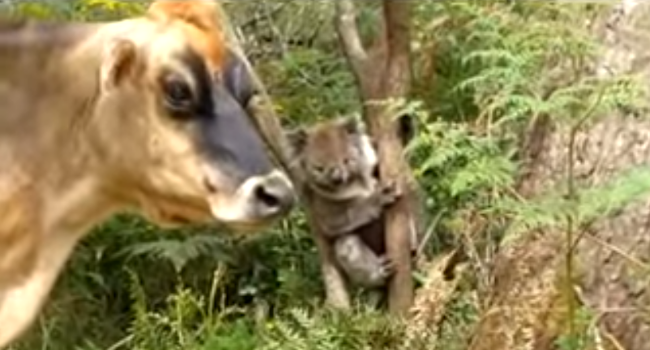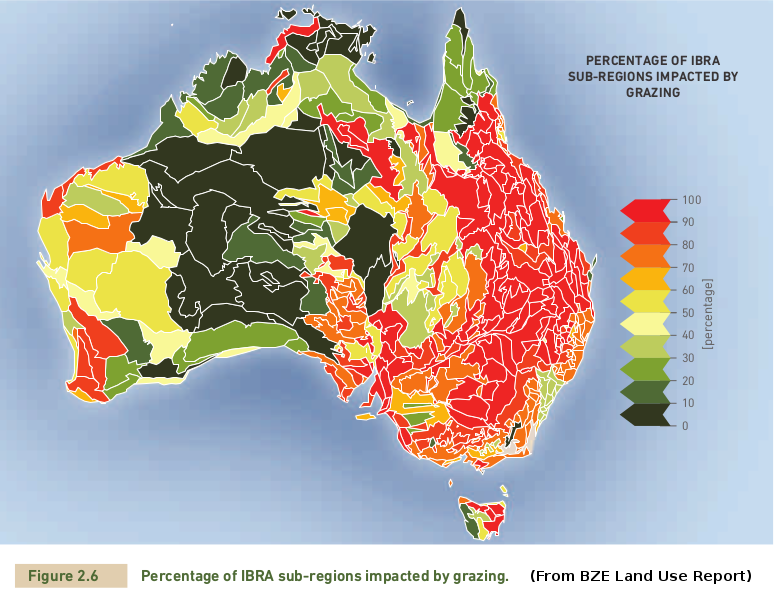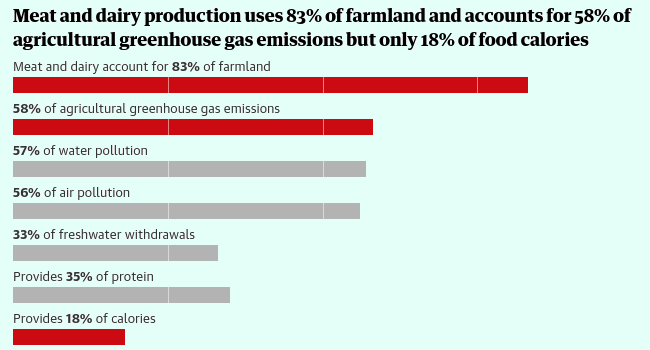
Many native animal species in Australia are at risk of becoming extinct. The key threat to Australian fauna is habitat loss through land clearing, both past and continuing, and the key driver for this clearing is the production of animal products.
In a submission to an Australian government inquiry into Australia's faunal extinction crisis, Vegan Australia urged the government to move towards a vegan agricultural system to help save koalas and many other threatened species.
Read the full submission below.
Vegan Australia is pleased to have the opportunity to provide a submission to the Senate Standing Committees on Environment and Communications inquiry into Australia's faunal extinction crisis. We hope this submission assists the committee in recommending actions to address the decline in the population of Australia's threatened fauna species.
Vegan Australia is a national organisation that informs the public about animal rights and veganism and also presents a strong voice for veganism to government, institutions, corporations and the media. Vegan Australia envisions a world where all animals live free from human use and ownership. The foundation of Vegan Australia is justice and compassion, for animals as well as for people and the planet. The first step each of us should take to put this compassion into action is to become vegan and to encourage others to do the same. Veganism is a rejection of the exploitation involved in commodifying and using sentient beings.
This inquiry is an opportunity for the community to reflect on how the production of animal products is damaging to many aspects of the environment, including by threatening many native species. Every year over half a billion farmed animals are bred, raised and killed for food in Australia. The UN has identified animal agriculture as 'one of the most significant contributors to today's most serious environmental problems', including global warming, species extinction, loss of fresh water, forest destruction, air and water pollution, acid rain, salinity, soil erosion and loss of habitat.
By acknowledging the impact of animal agriculture on the environment, this inquiry allows us to consider alternative ways we can obtain food which do not involve both the suffering of farmed animals and the environmental havoc animal agriculture causes.
We note that the goals of this inquiry are to identify key threats to Australia's threatened fauna species and to identify how to ensure their conservation.
The key threat to many of Australia's native animals is habitat loss through land clearing, both past and continuing.
A shocking report by WWF-Australia found that millions of native animals are killed each year due to the bulldozing of their forest and woodland habitats. While this report concentrates on Queensland, we believe many of its finding are relevant across Australia.
The WWF-Australia study estimates that tree clearing in Queensland alone kills about 34 million native mammals, birds and reptiles every year, comprising 900,000 mammals, 2.6 million birds and 30.6 million reptiles.
Bulldozing of habitat, past and ongoing, is a major factor in the 80% decline of koalas in Queensland's Koala Coast.
In a departure from many conservation and environmental organisations, the WWF-Australia report focuses on the experiences of individual animals rather than solely on conservation of habitat and species. It states "the fate of all native vertebrate animals is considered important, regardless if the species is threatened or common". The report looks at the suffering and death individual animals experience due to habitat destruction.
The report also states that "cruelty and animal suffering, whether intentional or not, is abhorrent to most Australians" and that there will be strong public support for action.
Habitat loss inevitably leads to suffering and death of the individuals inhabiting an area to be cleared. Species affected include koalas, quolls, bats, bandicoots, native rodents, possums and gliders. Close to a million mammals are estimated to die each year from clearing.
The impact on animals resident in an area to be cleared is immense. Many die during clearing, crushed by machinery or falling trees. Many others die slowly over days or weeks, from injuries, starvation or exposure. Animals left behind in the cleared landscape are highly exposed and vulnerable to predators. Some die when log piles they are sheltering in are burnt or chipped into mulch by machines.
Animals who flee from the clearing suffer on the way - in collisions with vehicles, fences or powerlines, taken by predators, or due to injuries, exposure, starvation, dehydration or disease. If the clearing is extensive or other habitat patches are distant, many animals, particularly the small and young, will die before being able to reach new habitat.
Other deprivations suffered by animals due to clearing include suffocation, starvation, dehydration, heat exposure, heat stroke, infection and disease.
The report claims that "habitat destruction through tree-clearing probably counts as Queensland's and possibly also Australia's single largest crisis of animal welfare."
Animal agriculture is the key driver for habitat clearing and destruction in Australia.
Native vegetation is still being cleared for agriculture in Australia, with about 90% of that used to open up new areas for grazing pasture for animal farming. Queensland is the nation's leader in current land clearing. While NSW is continuing to clear land to some extent, much of the state has already been cleared. For Australia as a whole, agricultural land occupies 53% of the Australian landmass, with 91% of this used for animal agriculture. By comparison about 4% of Australia is used for plant farming, 2% for forestry, 0.4% for urban development and 0.02% for mining.
Despite what many people claim, the issue is not urban development, mining, plant monocultures or forestry. The main driver for land clearing in Australia is animal agriculture.
As the Beyond Zero Emissions Land Use Report says "Since colonisation Australia has seen more biodiversity loss than any other continent and this rate is still one of the highest globally. Deforestation and grazing pressure are the major threats to biodiversity, and cause stress to a range of ecological communities across the continent."
As can be seen from Figure 2.6 of the BZE Land Use Report, nearly all of the intensive agricultural zone has been impacted by grazing.

Dur to these enormous pressures, there are concerns for many animal species as well as the continuation of the human population due to environmental destruction, especially from climate change. All this is in addition to the over half a billion farmed animals bred, raised and killed for food in Australia every year.
For these reasons we need to end land clearing for animal agriculture, start to revegetate previously cleared land and then work towards phasing out the animal agriculture industry throughout Australia.
Vegan Australia's recommendation to phase out animal agriculture implies a change to a plant-based diet for the people of Australia. Nutritional science shows that humans have no need for farmed animal food products. In fact, there is a solid body of peer-reviewed scientific evidence to confirm that it actually benefits human health to consume a primarily plant-based diet. Changing to a plant-based diet can help people live a longer, healthier life, and significantly reduce risk of falling victim to many of the serious health threats facing Australians today.
Australia's peak health body, the National Health and Medical Research Council, recognises that a vegan diet is a viable option for all Australians. Australia's top health experts agree with those in other parts of the world that well-planned vegan diets are safe and healthy for all age groups. The Australian Dietary Guidelines state that alternatives to animal foods, such as nuts, seeds, legumes, beans and tofu, can "increase dietary variety and provide a valuable and affordable source of protein and other nutrients found in meats."
According to the US Academy of Nutrition and Dietetics, "Appropriately planned ... vegan diets are healthful, nutritionally adequate, and may provide health benefits for the prevention and treatment of certain diseases. These diets are appropriate for all stages of the life cycle, including pregnancy, lactation, infancy, childhood, adolescence, older adulthood and for athletes."
Not only are animal products unnecessary for optimal health, an increasing number of nutritionists and health professionals are acknowledging animal products are harmful to our health. This is supported by decades of good research. A healthy vegan diet helps reduce the risk of heart disease, stroke, cancer, obesity, and diabetes, some of Australia's top killers. The World Health Organisation has stated that processed meats such as bacon cause cancer and the red meat is a probable cause of cancer.
A recent issue of the Medical Journal of Australia, dedicated to the question "Is a Vegetarian [including vegan] Diet Adequate?", included the following statements. "A varied and balanced plant-based diet can provide all of the nutrients needed for good health." "Most vegans meet the recommended daily intake for protein." "Vegan diets generally contain just as much or more iron than mixed diets containing meat." "BMI and obesity was lowest for vegans."
The China Study by T Colin Campbell is one of the most comprehensive studies on nutrition ever done. Campbell provides compelling evidence linking animal products to disease, including cancer, heart disease, osteoporosis, diabetes, etc.
Every current vegan, by simply being vegan, proves that causing harm to sentient farmed animals is not necessary.
The committee has been asked to inquire into key threatening processes leading to species extinction. One of these is climate change, which will have a disastrous effect on animal species as well as plant species and humans. Some have called the current climate emergency the "Sixth Mass Extinction". So to protect our native fauna from extinction we need to urgently tackle the climate crisis.
Animal agriculture is the leading cause of climate change. In Australia, animal agriculture emits about 50% of all greenhouse gases, when accounted over 20 years. Animal agriculture produces greenhouse gases through land clearing for grazing, methane produced by cows and sheep and emissions from manure.
In their greenhouse gas calculations, the IPCC and other international environmental organisations use warming potentials (GWPs) of greenhouse gases using a 100-year time frame. The decision to use a 100-year time frame is arbitrary. The IPCC states that "There is no scientific argument for selecting 100 years compared with other choices. The choice of time horizon is a value judgement." The convention to use a 100-year time frame was decided several decades ago, before the urgent need to avoid climate-system tipping points was understood. Given the urgency of the emissions reductions required to avoid catastrophic temperature increases, 20-year global warming potentials are much more relevant. Over 20 years, the global warming potential of methane is about 5 times higher than over 100 years. Animal agriculture is the largest source of methane and so if we measure the impact of sectors using a 20-year time frame, the climate impact of agriculture is significantly higher.
The IPCC and other groups also do not take into account the impact of short-term gases on global warming. In the short time we have available to overcome climate change, the global warming potential of these short-lived gases becomes much more significant. Most of these gases are emitted by animal agriculture.
When 20-year global warming potentials are used and short-term gases are included, we find that animal agriculture is responsible for about 50% of all greenhouse gases, both in Australia and worldwide.
Methane stays in the atmosphere on average about 12 years. This means that reductions in methane emissions will cause more immediate cuts to global warming than reductions in carbon dioxide emissions. Carbon dioxide can stay in the atmosphere for over 100 years, so even if carbon dioxide emissions (from, for example, burning fossil fuels) were reduced now, it would take many decades for this to have an effect on global warming.
Once we understand that animal agriculture is a major cause of global warming, a simple, effective and relatively quick solution becomes clear. By abolishing the use of animals for food, we not only act ethically for the animals, we also help slow and eventually reverse global warming.
The economic impact of removing animals from the agricultural system will not be as significant as many people imagine. The animal agriculture industry is a relatively small part of the modern Australian economy. It currently contributes about 1.2% to the Australian GDP and employs less than 1.5% of the Australian workforce.
Any negative economic impacts of phasing out animal agriculture should be carefully managed to avoid dislocation, by reskilling workers and reusing land for other purposes. Currently, over half of the Australian continent is used for animal agricultural. Much of this could be used for sequestering carbon which would remove carbon dioxide from the atmosphere and hence start to reverse global warming.
At an individual level, the single best thing you can do for the environment is to live vegan. At a national and worldwide level, the best thing we can do is to abolish the use of animals in the agriculture industry.
To achieve climate and social justice and avoid catastrophe, we need to work on multiple fronts. Yes, we need to transition to 100% renewable energy. Yes, we need to change cities so we depend on cars less. Yes, we need to make buildings more energy efficient. But we also need to move quickly to a vegan way of life.
Seriously tackling climate is the only hope of protecting Australia's native animals and humans.
A new UN environmental report, which found that around one million species are at risk of extinction, puts much of the blame on animal agriculture, saying that the meat industry has a "particularly heavy impact".
Of all the major causes of biodiversity loss listed by the report (such as destruction of forests and wetlands, overfishing, climate change and pollution), animal agriculture is the primary cause of the deterioration. Fortunately damage caused by animal agriculture may be the easiest to reduce, because most animal products can be replaced by plant products with a much lower environmental footprint. For this change to be successful, it will require environmental organisations and governments to strongly promote plant based diets.
The Global Assessment Report on Biodiversity and Ecosystem Services was released by IPBES, a UN organisation with over 100 member countries. The report also found that:
Note that the 18% figure for greenhouse gas emissions from animal agriculture is determined using a 100 year GWP time frame to compare methane and carbon dioxide. Using a 20 year time frame (much more relevant to the current climate emergency), the figure is about 50%. That is, about half of the world's greenhouse gas emissions are due to the animal agriculture industry.
The report also lists climate change, pollution and invasive species as damaging to nature, but these have had a relatively low impact compared to the surge in agriculture (mainly animal agriculture) and fishing which are the primary causes of the deterioration.

To help reverse some of this damage to the environment, the report recommends that meat consumption be reduced by changes in diet. It suggests that reducing meat consumption in higher-income countries would yield the largest potential gain for the environmental and health benefits.
It suggests "improvements in consumption patterns can likely be achieved by reducing subsidies for animal-based products, increasing those for plant-based foods, and replacing ecologically-inefficient ruminants (e.g., cattle, goats, sheep). Research and development of plant-based meat substitutes is also a growing phenomena and potential solution." It also suggests that meat prices are kept artificially low, which can increase consumption.
The report mentions that another driver for higher meat consumption is its promotion via advertising, which promotes images of identity, such as masculinity and national and cultural identity. "Given the central role of advertising and marketing in boosting production, policies might seek to rein in the reach of advertising, particularly to children and for resource-intensive products" (such as animal products). The report suggests that regulating the advertising of animal products could reduce their consumption and hence improve the sustainability of food.
The report notes that reduced demand for animal products can achieve multiple goals, such as greenhouse gas emission reduction, food security and biodiversity protection.
While the report does not call for a vegan diet, it does suggest that the less meat, dairy and egg in a diet, the better for the environment and for health. Some scenarios mentioned in the report call for 50% less meat consumption. Regarding the environment, the best future scenario beneficial for biodiversity envisioned by the report includes "a shift in diet towards less meat." It also states that "significant reduction in consumption of meat and eggs means that less agricultural production would be required, thus reducing associated biodiversity loss." Regarding health, the report notes that "diet related disease is the leading cause of premature mortality." and "increased consumption of fruits and vegetables is associated with reductions in various diseases such as cardiovascular disease."
In other words, the report is consistent with moving towards a vegan world.
For decades, hundreds of exotic plant species have been introduced as feed for animal agriculture and have now become invasive weeds which threaten the environment, cause habitat loss and threaten biodiversity.
One such species is Gamba grass which was originally introduced to Australia as a pasture species for cattle. It is now a significant invasive week in several parts of Australia and increases the frequency and intensity of wildfires and competes with native grasses. See the ABC News article 'Indigenous rangers dismayed as NT Government allows cattle station to graze gamba grass weed'.
By ending animal agriculture, we will not only free up land needed for biodiversity and end the suffering of over half a billion farmed animals every year, but also begin to reverse the damaging impact of invasive pasture grasses.
Run-off caused by animal agriculture is killing the Great Barrier Reef. The Wilderness Society has found that more than 90% of land clearing in Great Barrier Reef catchments between 2013 and 2018 was attributable to the beef industry.
According to Meat Eaters vs the Great Barrier Reef by Paul Mahony, "a major contributing factor has been erosion from livestock grazing (including related tree clearing), which releases sediment and nutrients (nitrogen and phosphorous) to the Great Barrier Reef waters via nearby streams and rivers. The sediment inhibits coral growth and promotes the excessive development of algae, while the nutrients contribute to outbreaks of crown-of-thorns starfish, which have had a devastating impact."
Springvale cattle station near Cooktown in Far North Queensland was one of the biggest polluters in the Normanby catchment, with a Griffith University study finding that every year it generated 460,000 tonnes of sediment run-off into the Great Barrier Reef waters. In 2016, the Queensland Government bought Springvale station. Since then, all cattle have been removed and degraded grazing land is being restored to help protect the reef from silt.
The 560 square kilometre property has been declared a nature refuge. Conservation groups hailed the "unprecedented" land purchase as a win for the World Heritage-listed area.
Environment Minister Steven Miles said steps will be taken to restore badly degraded grazing land on the property, which generated 460,000 tonnes of sediment run-off every year. The property was responsible for 40 per cent of sediment from gully erosion in the Normanby basin. He said eroded gullies could be "smoothed out" and planted to grass.
Dr Miles said the acquisition was also critical to conservation as Springvale was home to threatened species the southern cassowary, northern quoll and red goshawk.
Not only does clearing cause polluting run-off, but erosion from cattle grazing in uncleared areas also causes extensive sediment release.
To make it easier to understand the scale of the issue of cattle grazing and reef destruction, Paul Mahony, in Beef, the reef and rugby: We have a problem, measures the clearing of land for animal agriculture in terms of rugby league fields. In Queensland alone, three-quarters of a rugby league field is cleared every minute.
The report also states:
A report by the CSIRO states that "Land clearing, primarily for agriculture, is perhaps the single most important cause of environmental degradation, loss of species, and depletion of ecological communities."
By removing animals from agriculture, a large proportion of land cleared for animal agriculture in Australia will be freed up. This will allow regrowth and reforestation which will have many environmental benefits, including strengthening ecosystems, increasing biodiversity and allowing endangered species to recover and possibly preventing extinctions in the future.
In addition, the end of the use of animals in agriculture will avoid an enormous amount of suffering to the over half a billion farmed animals who are bred, raised and killed for food every year in Australia. Each animal values their life and doesn't want to die.
This committee has been charged with examining the obligations of the Government in conserving threatened fauna, the adequacy of environment laws and protections for habitat and the adequacy of funding for preventing threatened fauna loss.
We urge the committee to recognise that animal agriculture is a key threat to native fauna in Australia and to make recommendations for actions based on this. These actions should include policy, legislation and regulations to:
The members of the committee should ask themselves if it is important to save endangered species, and then if it is, why the same logic should not be used to save farmed animals? Please see the references to carnism and speciesism below.
We also strongly support the submission to this inquiry made by Paul Mahony.
Greg McFarlane
Vegan Australia

© Vegan Australia | Registered as a charity by the ACNC | ABN 21 169 219 854